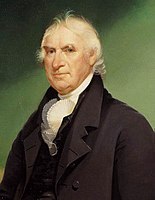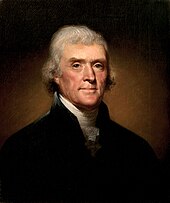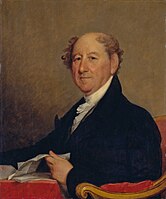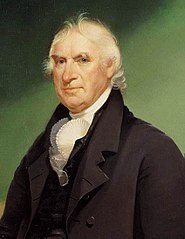User:Devsfan11/sandbox/1808 Presidential Election
Cite error: There are <ref> tags on this page without content in them (see the help page).= 1808 United States Presidential Election =
| |||||||||||||||||||||||||||||
176 members of the Electoral College 89 electoral votes needed to win | |||||||||||||||||||||||||||||
|---|---|---|---|---|---|---|---|---|---|---|---|---|---|---|---|---|---|---|---|---|---|---|---|---|---|---|---|---|---|
| Turnout | 41.2% | ||||||||||||||||||||||||||||
| |||||||||||||||||||||||||||||
| |||||||||||||||||||||||||||||
The 1808 United States presidential election was the sixth quadrennial presidential election held from Friday, November 4, to Wednesday, December 7, 1808. The Democratic Republican Candidate James Madison narrowly defeated Federalist candidate John Quincy Adams.
Madison had served as Secretary of State since President Thomas Jefferson took office in 1801. Jefferson, who had declined to run for a third term, threw his strong support behind Madison, a fellow Virginian. Sitting Vice President George Clinton and former Ambassador James Monroe both challenged Madison for leadership of the party, but Madison won his party's nomination and Clinton was re-nominated as vice president. The Federalists chose to nominate John Quincy Adams, a Senator from Massachusetts. Adams had gained significant national prominence following his public call for the impeachment of President Thomas Jefferson and the subsequent Supreme Court Case, United States v. Adams.
The unpopularity of the Embargo Act of 1808 signifcantly harmed Madison in New England as he failed to win a single state in the region. Despite the unpopularity of the Embargo Act of 1808 in the New England region of the United States, Madison remained popular in the South. Many Southern states saw their economies grow as a result of the Embargo Act as trade with France increased. Southern raw materials saw increasing demand in France and in New England, where many manufacturers looked to create a new internal market for finished goods that would have previously been imported from Great Britain. Although the Embargo Act of 1808 would be important in developing the manufacturing industry in New England, and would largely be the reason for their future industrial dominance, startup costs on new manufacturing were heavy and the act spurred a brief debt crisis among the manufacturers there, largely why it remained unpopular.
Nominations[edit]
Democratic-Republican Party Ticket[edit]
 | |||||||||||||||||||||||||||||
| James Madison | George Clinton | ||||||||||||||||||||||||||||
|---|---|---|---|---|---|---|---|---|---|---|---|---|---|---|---|---|---|---|---|---|---|---|---|---|---|---|---|---|---|
| for President | for Vice President | ||||||||||||||||||||||||||||
 |
 | ||||||||||||||||||||||||||||
| 5th U.S. Secretary of State (1801–1809) |
4th Vice President of the United States (1805–1812) | ||||||||||||||||||||||||||||

Presidential candidates[edit]
- James Madison (Virginia), Secretary of State
- James Monroe (Virginia), Former U.S. Ambassador to the United Kingdom
- George Clinton (New York), Vice President of the United States
Vice-presidential candidates[edit]
Nomination[edit]
James Madison was easily nominated during the congressional nominating caucus, winning 87 of 89 members of the caucus. Former United States Ambassador to the United Kingdom, James Monroe launched a spirited campaign against Madison after President Thomas Jefferson refused to submit the Monroe-Pinkey treaty to the Senate. Monroe believed Jefferson was trying to avoid putting Monroe in the national spotlight and thus avoid elevating him to the Presidency. Monroe's campaign would not garner much support, outside of support from a few delegates from Virginia, as Madison worked to alleviate Monroe's concerns. Monroe would refuse to support Madison for President but the Democratic-Republicans avoided a national split of the party. Monroe would remain within the party and would easily win the Democratic-Republican nomination in the 1816 United States Presidential election.
Clinton faced no opposition to his renomination for Vice President, running unopposed. This marks the first, and only, time in American history where the incumbent Vice President was re-nominated under a different President.
Federalist Party nomination[edit]
 | |||||||||||||||||||||||||||||
| Charles C. Pinckney | Rufus King | ||||||||||||||||||||||||||||
|---|---|---|---|---|---|---|---|---|---|---|---|---|---|---|---|---|---|---|---|---|---|---|---|---|---|---|---|---|---|
| for President | for Vice President | ||||||||||||||||||||||||||||
 |
 | ||||||||||||||||||||||||||||
| 6th U.S. Minister to France (1796–1797) |
3rd U.S. Minister to Great Britain (1796–1803) | ||||||||||||||||||||||||||||
Presidential Candidates[edit]
- John Quincy Adams (Massachusetts)
- Timothy Pickering (Massachusetts)
- Charles C. Pinckney (South Carolina)
Vice-Presidential Candidates[edit]
-
Former United States Senator, Rufus King of New York
Nomination[edit]
Many believed that John Quincy Adams was going to the Federalist nominee for President of the United States following his rise to national popularity because of his opposition to the Embargo Act of 1808 and his call for the impeachment of President Thomas Jefferson. Adams faced little opposition at the Federalist Nomination Caucus but did have two minor challengers, Timothy Pickering of Massachussetts and Charles c. Pinckney of South Carolina. Pickering challenged Adams claiming that he was too close with many prominent Democratic-Republicans, in particular James Monroe who Adams shared frequent correspondance with. Pinckney, a South Carolina native, believed that Adams was too radical. Pinckney was one of the only federalists to speak out in support of Thomas Jefferson when Adams called for his impeachment. Pinckney had previously been the Federalist Party nominee for the 1804 United States Presidential Election, losing to Thomas Jefferson. Neither Pickering nor Pinckney were able to gain significant support at the caucus.
Former United States Senator of New York, Rufus King, was nominated for Vice President.








